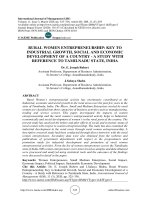Economic growth and economic development 361
Bạn đang xem bản rút gọn của tài liệu. Xem và tải ngay bản đầy đủ của tài liệu tại đây (114.8 KB, 1 trang )
Introduction to Modern Economic Growth
The first term must be equal to zero, since otherwise limt→∞ V (t, xˆ (t)) = ∞ or
−∞, and the pair (ˆ
x (t) , yˆ (t)) cannot be reaching the optimal solution. Therefore
x (t) , yˆ (t)) = lim exp (−ρt) µ (t) x˙ (t) = 0.
lim exp (−ρt) µ (t) g (ˆ
(7.56)
t→∞
t→∞
Since limt→∞ V (t, xˆ (t)) exists and f and g are weakly monotone, limt→∞ yˆ (t) and
limt→∞ xˆ (t) must exist, though they may be infinite (otherwise the limit of V (t, xˆ (t))
would fail to exist). The latter fact also implies that limt→∞ x˙ (t) exists (though it
may also be infinite). Moreover, limt→∞ x˙ (t) is nonnegative, since otherwise the
condition limt→∞ x (t) ≥ x1 would be violated. From (7.52), (7.54) implies that as
t → ∞, λ (t) ≡ exp(−ρt)µ(t) → κ for some κ ∈ R+ .
Suppose first that limt→∞ x˙ (t) = 0. Then limt→∞ xˆ (t) = xˆ∗ ∈ R (i.e., a
finite value). This also implies that f (ˆ
x (t) , yˆ (t)), g (ˆ
x (t) , yˆ (t)) and therefore
fy (ˆ
x (t) , yˆ (t)) and gy (ˆ
x (t) , yˆ (t)) limit to constant values. Then from (7.51), we
have that as t → ∞, µ (t) → µ∗ ∈ R (i.e., a finite value). This implies that κ = 0
and
lim exp (−ρt) µ (t) = 0,
(7.57)
t→∞
and moreover since limt→∞ xˆ (t) = xˆ∗ ∈ R, (7.55) also follows.
x (t), where g ∈ R+ , so that xˆ (t) grows at an
Suppose now that limt→∞ x˙ (t) = gˆ
exponential rate. Then substituting this into (7.56) we obtain (7.55).
x (t), for any g > 0, so that xˆ (t) grows
Next, suppose that 0 < limt→∞ x˙ (t) < gˆ
at less than an exponential rate. In this case, since x˙ (t) is increasing over time,
(7.56) implies that (7.57) must hold and thus again we must have that as t → ∞,
λ (t) ≡ exp(−ρt)µ(t) → 0, i.e., κ = 0 (otherwise limt→∞ exp (−ρt) µ (t) x˙ (t) =
limt→∞ x˙ (t) > 0, violating (7.56)) and thus limt→∞ µ˙ (t) /µ (t) < ρ. Since xˆ (t)
grows at less than an exponential rate, we also have limt→∞ exp (−gt) xˆ (t) = 0
for any g > 0, and in particular for g = ρ − limt→∞ µ˙ (t) /µ (t). Consequently,
asymptotically µ (t) xˆ (t) grows at a rate lower than ρ and we again obtain (7.55).
x (t) for any g < ∞, i.e., xˆ (t) grows at
Finally, suppose that limt→∞ x˙ (t) > gˆ
more than an exponential rate. In this case, for any g > 0, we have that
˙ ≥ g lim exp(−ρt)µ(t)ˆ
x(t) ≥ gκ lim xˆ(t) ≥ 0,
lim exp(−ρt)µ(t)x(t)
t→∞
t→∞
t→∞
347









